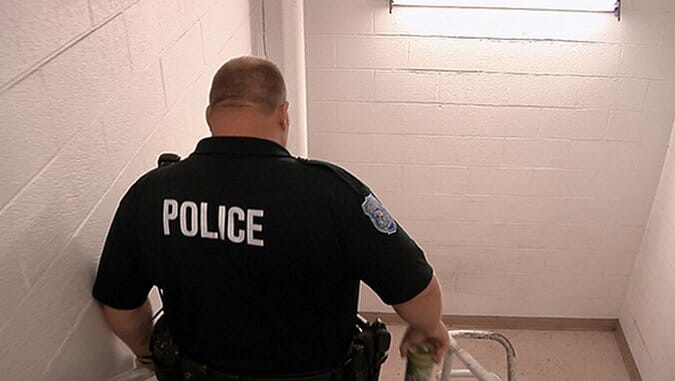
If you’ve been paying the slightest attention, you may have heard: Baltimore is on fire. If you’ve paid more attention than that, you might be aware that the United States of America has lately had a problem with police-involved shootings—though it doesn’t take a true scholar of our law enforcement’s history with racialized killings to know that the narrative played out in the stories of Freddie Gray, Michael Brown, Walter Scott, Tamir Rice and Eric Garner has long been a part of our national fabric. So with this recent spate of fatal incidents fresh on our minds, we might be inclined to engage with taser exposé Tom Swift and His Electric Rifle in a preconceived fit of righteous indignation.
But the story of how the taser rose to prominence as a tool of serving and protecting doesn’t quite align with the story of how each of these men wound up dead. That’s because director Nick Berardini, collaborating with Fight Church editor Bryan Storkel, is neither prescient nor vulturous. (It’s also worth noting that much of the film’s factual narrative occurs in Canada.) He’s not interested in being timely, though Tom Swift and His Electric Rifle certainly carries the unmistakable scent of timeliness. Instead, he’s interested in sweeping the legs of the brothers Smith, founders of TASER International, the company responsible for manufacturing and distributing conducted electrical weapons such as, well, the taser. All the same, there’s a sense of coincidence to Tom Swift and His Electric Rifle’s Tribeca debut. Why TASER International? Why now?
Spend five minutes watching the film’s deposition footage and you’ll understand why: The Smith Bros are spin-master scumbags of the highest order. When they’re not twisting truth to suit their needs, they’re outright lying. Amazingly, Tom Swift and His Electric Rifle gives both men the benefit of the doubt; Berardini wants to believe that Rick and Tom Smith went into business with taser developer Jack Cover with the best of intentions. But there’s a saying that suggests the road to hell is paved with those, so viewers may be pardoned if over time the goodwill they might initially feel for the Smiths dissolves into enmity.
Look, the idea of the taser—a device that allows cops to stop aggressors without relying on deadly force—sounds like a godsend on paper. Cover and the Smiths like to point out that when their critics reference taser-related death statistics, the number of lives that tasers have “saved” is left in the margins. They’re probably not wrong, either, and Tom Swift and His Electric Rifle doesn’t bother trying to argue otherwise. Tasers probably do reduce the number of officers killed in the line of duty. They probably have limited the tally of suspects murdered in the process of apprehension. But neither Rick, nor Tom, nor Jack grasp that if their device is capable of taking a life under any circumstance, then they aren’t living up to their own ambitions. Therein lies Berardini’s critique: using naught but his subjects’ own words, he paints a portrait of men who have been dazzled by profits at the expense of their ethics.
In between these moments, as well as a few spicy interviews with liability lawyers and medical experts, the film leans pretty heavily on security camera footage of infamous instances in which the taser proved lethal. Notably, we see from start to finish the awful, lonesome death of Polish immigrant Robert Dzieka?ski and Missouri resident Stanley Harlan, who in 2008 died right before his mother’s eyes while the parties responsible did jack shit to help him. (For these sequences alone, Tom Swift and His Electric Rifle isn’t for the faint of heart.) A lesser doc would tweak the rather damning evidence of the Smiths’ reckless irresponsibility to make them look like unrepentant monsters. The longer that aforementioned deposition footage goes on, though, the more drained and the more human these guys seem. The weight of their misdeeds presses down on them. If the taser isn’t at the heart of our nation’s systemic barbarism, its use and misuse in law enforcement remains no less troubling. Good for Berardini for sparking a dialogue about it.
Director: Nick Berardini
Writer: Nick Berardini
Release Date: April 17, 2015 (Tribeca Film Festival)
Boston-based critic Andy Crump has been writing online about film since 2009, and has been scribbling for Paste Magazine since 2013. He also contributes to Screen Rant, Movie Mezzanine, and Badass Digest. You can follow him on Twitter. He is composed of roughly 65% Vermont craft brews.